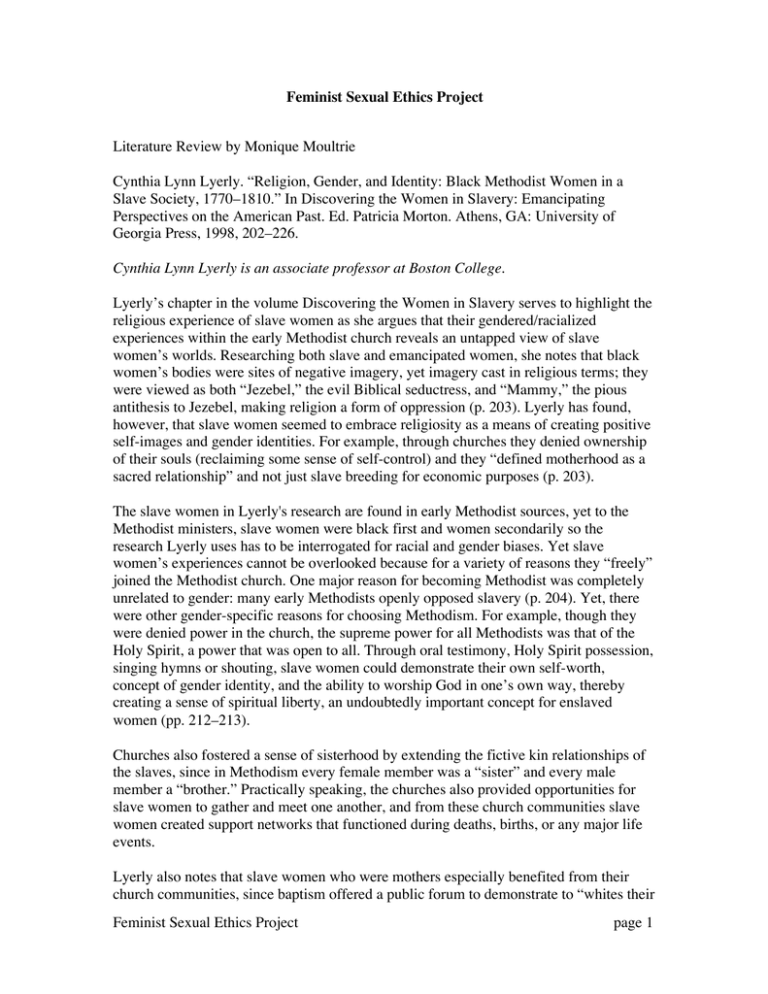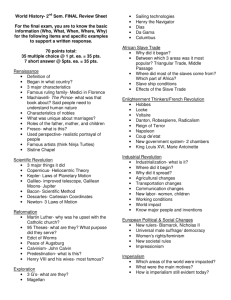
Feminist Sexual Ethics Project
Literature Review by Monique Moultrie
Cynthia Lynn Lyerly. “Religion, Gender, and Identity: Black Methodist Women in a
Slave Society, 1770–1810.” In Discovering the Women in Slavery: Emancipating
Perspectives on the American Past. Ed. Patricia Morton. Athens, GA: University of
Georgia Press, 1998, 202–226.
Cynthia Lynn Lyerly is an associate professor at Boston College.
Lyerly’s chapter in the volume Discovering the Women in Slavery serves to highlight the
religious experience of slave women as she argues that their gendered/racialized
experiences within the early Methodist church reveals an untapped view of slave
women’s worlds. Researching both slave and emancipated women, she notes that black
women’s bodies were sites of negative imagery, yet imagery cast in religious terms; they
were viewed as both “Jezebel,” the evil Biblical seductress, and “Mammy,” the pious
antithesis to Jezebel, making religion a form of oppression (p. 203). Lyerly has found,
however, that slave women seemed to embrace religiosity as a means of creating positive
self-images and gender identities. For example, through churches they denied ownership
of their souls (reclaiming some sense of self-control) and they “defined motherhood as a
sacred relationship” and not just slave breeding for economic purposes (p. 203).
The slave women in Lyerly's research are found in early Methodist sources, yet to the
Methodist ministers, slave women were black first and women secondarily so the
research Lyerly uses has to be interrogated for racial and gender biases. Yet slave
women’s experiences cannot be overlooked because for a variety of reasons they “freely”
joined the Methodist church. One major reason for becoming Methodist was completely
unrelated to gender: many early Methodists openly opposed slavery (p. 204). Yet, there
were other gender-specific reasons for choosing Methodism. For example, though they
were denied power in the church, the supreme power for all Methodists was that of the
Holy Spirit, a power that was open to all. Through oral testimony, Holy Spirit possession,
singing hymns or shouting, slave women could demonstrate their own self-worth,
concept of gender identity, and the ability to worship God in one’s own way, thereby
creating a sense of spiritual liberty, an undoubtedly important concept for enslaved
women (pp. 212–213).
Churches also fostered a sense of sisterhood by extending the fictive kin relationships of
the slaves, since in Methodism every female member was a “sister” and every male
member a “brother.” Practically speaking, the churches also provided opportunities for
slave women to gather and meet one another, and from these church communities slave
women created support networks that functioned during deaths, births, or any major life
events.
Lyerly also notes that slave women who were mothers especially benefited from their
church communities, since baptism offered a public forum to demonstrate to “whites their
Feminist Sexual Ethics Project
page 1
affection, love, and concern for their children,” hence revealing to whites their humanity
(p. 216). Being slaves, they had no recognized maternal rights to their children, but
having their children baptized perhaps meant that God would watch over their children if
they were separated and offered the hint of a family reunion in heaven for those who had
been separated through the slave trade or death. Clergymen also served as allies for slave
mothers; they advocated keeping families together since Methodists considered
motherhood to be a “sacred office” (p. 218).
Lyerly is careful to mention that the slave women’s positive experiences in Methodism
should not overshadow the everyday abuse that they endured and that was even condoned
in the later years by the Methodist church (the church’s official position against slavery
weakened over the years covered by Lyerly). For instance, the church did not speak
openly against the sexual abuse of slave women by white men, and slave women were
usually confined to “black classes” of worshippers to discourage them from viewing
white women and men as their equals (p. 211, 214).
However, Lyerly is principally concerned with showing the ways that Methodism was
beneficial to slave women. Thus, when Methodism offered slave women the ability to be
“sanctified,” or attain perfect moral purity and absolute holiness, these slave women
thereby had the opportunity to counter the sexually promiscuous imagery prevalent (p.
210). The creation of the pious Mammy imagery certainly eased the fears of whites, but
Lyerly seeks to critique this imagery’s effect on enslaved women, even as they adapted it
for their own benefit. Whether this benefit was physical emancipation or spiritual
freedom, she illuminates black women’s religious experiences as areas for future
research.
http://www.brandeis.edu/projects/fse/
Feminist Sexual Ethics Project
page 2





